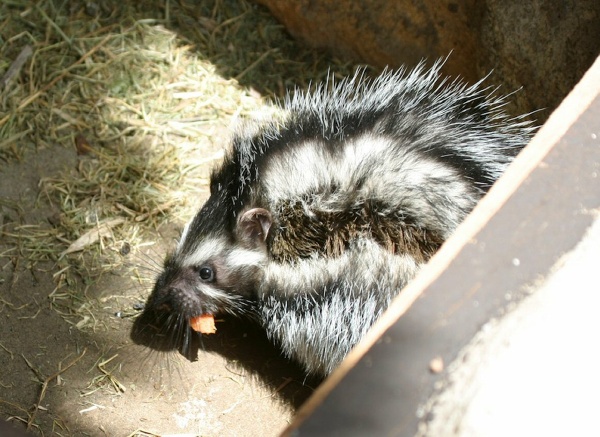A species of rat makes its own poison by gnawing on a toxic tree and then slathering poisonous spit onto special absorbent hairs on its flanks, a team of Oxford University and East African scientists have discovered.
The Crested Rat, Lophiomys imhausi, is the first mammal ever found to acquire lethal toxin from a plant. It acquires the poison, ouabain, from the bark of ‘Poison-arrow trees’, Acokanthera, so-called because human hunters extract ouabain from them to coat arrows that can kill an elephant.
‘At between 40 and 50 centimeters long The Crested Rat looks quite innocuous as it clambers about in rocky, wooded valleys in Kenya and the Horn of Africa,’ said Jonathan Kingdon of Oxford University’s Department of Zoology, an author of the paper. ‘But once disturbed or attacked the long fur on its flanks parts to expose a vivid black and white pattern around a leaf-shaped tract of peculiarly specialised hair, almost as if it is ‘daring’ a predator to take a bite of these poisoned hairs.
’The poisoned hairs are very close to the vital centres of the rat’s head, neck and thorax, so these are protected with shields of bone, a reinforced backbone, and skin tough enough to resist all but the sharpest of bites.

Lophiomys imhausi, the Crested Rat. Credit: Susannah Rouse
Jonathan Kingdon said, ‘We observed the rat gnawing Poison-arrow tree bark directly from the plant, chewing it and then deliberately slathering the resulting mixture onto its specialised flank hairs. These hairs are designed to rapidly absorb the poisonous mixture, acting like a lamp wick.
’Professor Fritz Vollrath of Oxford University’s Department of Zoology, an author of the paper, said: ‘None of us had ever seen complex hair such as these with a latticework for the wall and a bundle of fine fibres for the core. It was surprising how effectively the hair was in 'wicking-up' liquids, and in then holding them fast. While the function of a reservoir for the poison was clear, we shied away from testing it by chewing a hair!’
Ouabain is well-known as a heart-stopping cardiac glycoside and for centuries doctors have used minute doses of ouabain to stimulate weak hearts. The Crested Rat appears to be completely immune to this poison; the researchers hope that finding out more about the chemistry and genetics of the Crested Rat’s immunity to and use of ouabain could lead to new medicines for humans.
Citation: Jonathan Kingdon, Christopher Holland, Thomas Gheysens, Maxime Boulet-Audet, Fritz Vollrath, Bernard Agwanda, Margaret Kinnaird, Timothy O’Brien, ‘A poisonous surprise under the coat of the African Crested Rat’, Proceedings of the Royal Society B